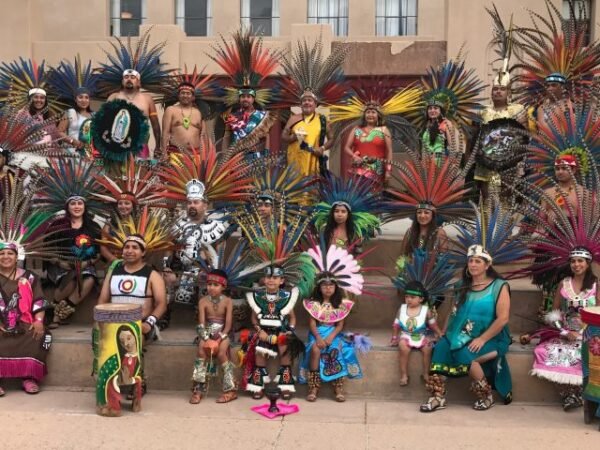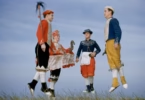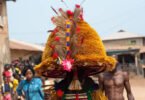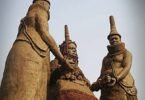
The Navajo Nation is also known as the Diné. Stands as the Native American reservation, across the United States, with a rich cultural heritage dating back centuries ago. They primarily reside within the Four Corners region of the American Southwest – Arizona, New Mexico, Utah and Colorado. Have gracefully embraced external influences and transformations over centuries while steadfastly preserving their lively traditions and spiritual convictions.
This article delves into the spiritual beliefs of the Navajo community. Explores their unique perspective, on the world as well as the significance of their customs, in shaping their daily lives and routines.
1. The Navajo Worldview: A Harmony with Nature
At the heart of Navajo culture is the concept of Hózhó, a word that means harmony, balance, beauty, and order. This fundamental principle underscores their relation with nature and their search for spiritual and physical balance.
Harmony and Nature
- The Navajo believe humans, animals, plants, and the earth are related. Nature has to be treated with respect and protected to lead a harmonious life.
- Mountains, rivers, and certain terrains have deep spiritual meanings, representing the dwellings of divine beings and the spirits of ancestors.
Four Sacred Mountains
The Navajo homeland is demarcated by four sacred mountains:
- Mount Blanca (Colorado): Represents the east.
- Mount Taylor (New Mexico): Represents the south.
- San Francisco Peaks (Arizona): Represents the west.
- Mount Hesperus (Colorado): Represents the north.
These mountains are not only geographical markers but also spiritual guardians of the Navajo people.
2. Creation Stories and Spiritual Beliefs
Traditionally, Navajo spirituality is rooted in oral traditions and creation stories that explain their origins as well as the structure of the universe.
The Diné Bahaneʼ
The Navajo creation narrative known as Diné Bahane tells the tale of how the Navajo people transitioned from four preceding worlds into their Fifth World existence while teaching lessons, on ethics and harmony with nature and fellow beings.
- Holy People: The Holy People known as Diyin Diné’é hold a place, in Navajo beliefs and traditions as entities who play a vital role, in guiding and safeguardig the Navajo people.They are revered through ceremonies and prayers to show respect and honor to them.
- Changing Woman: Changing Woman is highly respected as she symbolizes vitality and rejuvenation in Navajo culture.Her role, in giving life to the Navajo people and guiding them to live in alignment, with natures balance is deeply valued.
3. Ceremonies and Rituals
Their rituals are a part of their practice centered around restoring harmony and promoting well being, for the body and soul.
Blessingway Ceremony
- One of the most salient Navajo ceremonies is the Blessingway (Hózhóójí), performed to invoke peace, bounty, and safeguard. It is usually performed for such events as births, marriages, and travels.
Healing Ceremonies
The Navajo believe that illness and misfortune result from disruptions in harmony. Healing ceremonies, performed by hatááli (medicine men), are designed to restore balance.
- Chantways: Specific chants and rituals address different ailments and spiritual concerns, often lasting several days.
- Sandpainting: Intricate sandpaintings created with colored powders depict sacred symbols and serve as a medium for healing.
Seasonal Rituals
- The Navajo celebrate seasonal changes through rituals that honor the earth and its cycles, ensuring agricultural prosperity and community well-being.
4. Role of Spiritual Leaders
The hatááli (medicine men) are spiritual leaders and healers within Navajo society, responsible for performing ceremonies and preserving sacred knowledge.
Responsibilities
- Conducting rituals and chants for healing and protection.
- Preserving oral traditions and sacred songs.
- Teaching younger generations about Navajo spirituality and customs.
Training and Knowledge
Becoming a hatááli requires years of training, during which apprentices learn intricate rituals, chants, and the meanings of sacred symbols.
5. Sacred Symbols and Art
Art is a profound expression of Navajo spirituality, reflecting their beliefs, stories, and connection to the natural world.
Sand painting
- Used in healing ceremonies, sand paintings are temporary artworks made with natural materials such as sand, crushed minerals, and charcoal.
- Each design holds symbolic meaning, depicting deities, animals, and elements of the universe.
Weaving and Pottery
- Navajo Weaving: Renowned for their intricate and symbolic designs, Navajo rugs and blankets often incorporate motifs representing harmony and the natural world.
- Pottery: Traditional pottery designs reflect Navajo cosmology and spiritual beliefs with patterns passed down through generations.
6. Cultural Practices and Daily Life
The Navajo way of life is deeply intertwined with their cultural and spiritual beliefs, shaping their customs and values.
Family and Community
- The Navajo people attach a lot of importance to family and community. Often, extended families live together with mutual support when it comes to daily life and ceremonies.
- Matrilineal Society: Lineage and inheritance are through maternal lines thus, women play a crucial role in Navajo culture.
Respect for Elders
The Elders are of revered position in the Navajo society as keepers of wisdom, history, and spiritual knowledge.
7. Contemporary Challenges and Cultural Preservation
Modern society has successfully held shackles over the Navajo people and their efforts toward preserving cultural and spiritual practices.
Challenges
- Loss of traditional knowledge due to urban migrations and alien influences.
- Sacred lands and resources are threatened by environmental dangers.
- Mere survival efforts are made to revive and to further the Navajo language that needs to be acknowledged culturally by the people themselves.
Preservation Efforts
- The Navajo Nation has developed cultural programs and schools to teach devotional practices and languages to the younger generation.
- Partnerships with museums and cultural organizations ensure documentation and celebrations for the heritage of the Navajo people.
8. Global Recognition and Inspiration
The way Navajos commit themselves to cultural and spiritual values has made the world take notice of them. The tenets of harmony, respect for nature, and community are universal principles of many peoples.
- Art and Craftsmanship: Globally, Navajo art and crafts are recognized and celebrated for their stunning beauty and cultural significance.
- Environmental Advocacy: The Navajos are at the forefront of environmental and sustainable living issues because their strong attachment to land qualifies them as environmentalists.
Conclusion
The cultural and spiritual beliefs of the Navajo people provide a valuable means for understanding what it means to live in harmony with or among worlds. They bring forth traditions—balance, respect, and interdependence—and create personal identities that still speak to the many who look for resources for their own connections to nature and community.
In the journey of modernization, the Navajo are opting for the paths that would preserve their heritage. Yet these have not been barriers against the thriving spirit and wisdom of the culture that commands respect in both local and universal terms.






